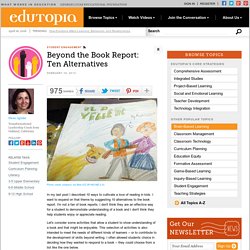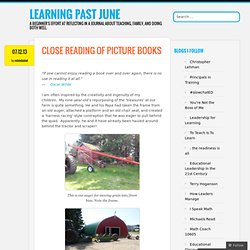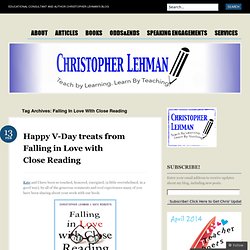

Beyond the Book Report: Ten Alternatives. In my last post I described 10 ways to cultivate a love of reading in kids.

I want to expand on that theme by suggesting 10 alternatives to the book report. I'm not a fan of book reports; I don't think they are an effective way for a student to demonstrate understanding of a book and I don't think they help students enjoy or appreciate reading. Let's consider some activities that allow a student to show understanding of a book and that might be enjoyable. This selection of activities is also intended to meet the needs of different kinds of learners -- or to contribute to the development of skills beyond writing. I often allowed students choice in deciding how they wanted to respond to a book -- they could choose from a list like the one below. 1. 2. 3. 4. 5. 6. 7. 8. 9. 10. This is by no means an exhaustive list of alternatives to book reports, but I hope it's spurred some thinking about how to get students to respond to books they read.
The Notice and Note Lessons for Reading Literary Texts presented at... Close Reading of Picture Books. “If one cannot enjoy reading a book over and over again, there is no use in reading it at all.” ― Oscar Wilde I am often inspired by the creativity and ingenuity of my children.

My nine-year-old’s repurposing of the ‘treasures’ at our farm is quite something. He and his Papa had taken the frame from an old auger, attached a platform and an old chair seat, and created a ‘harness racing’-style contraption that he was eager to pull behind the quad. Apparently, he and it have already been hauled around behind the tractor and scraper!
This is our auger for moving grain into/from bins. That’s my son, sitting on his invention (far right of picture). Safety aside (I don’t always agree with the activities my boys engage in at the farm, so I often don’t get told about them), his ‘new’ invention worked and he was over-joyed. I have just finished reading Notice and Note: Strategies for Close Reading by Kylene Beers and Robert Probst (Heinemann, 2013). Notice and Note helps teachers to (from ) Falling In Love WIth Close Reading. Welcome to the fifth week of our 7-week blog-a-thon on #closereading.

Each week posts are added to the Contributors page and we are looking forward to your addition. Let’s closely read the practice of close reading together! Also a reminder that we have two workshops coming up this December called “Fall in Love with Close Reading.” I will be in Brookfield, WI on December 6. Kate and I will be together in Amherst, NY on December 9. Complex What Now? If you are a Common Core State Standards state, the standards your state adopted have only one thing to say about the complexity of texts students should be able to read by themselves: In Reading Standard 10, across grade levels, the standard reads: “By the end of the year, read and comprehend literature/informational texts in the grades X-Y text complexity band proficiently, with scaffolding as needed…” One phrase that I find important: “by the end of the year.”
By basibanget used under Creative Commons lic I Choose Complex Kids, First Your Turn. Signposts. Notice and Note Powerpoint. Overview of 6 signposts. Close Reading with Informational Text. Close Reading - Vocab Focus - Grade 1. Kindergarten Close Reading Lesson 1. K close reading lesson 2. 2nd and 3rd Grade Close Reading. 2nd and 3rd grade close reading 2. Notice & Note Session 6 The Signposts Third gradePart 1. Fourth Grade Close Reading Lesson 1. Grades 3-5 Bringing Close Reading and Accountable Talk.